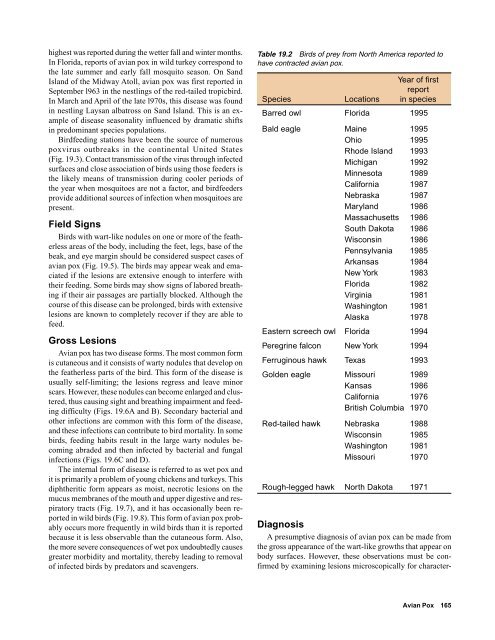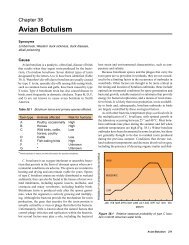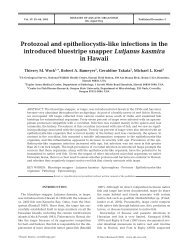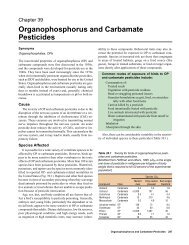Chapter 19 Avian Pox - National Wildlife Health Center
Chapter 19 Avian Pox - National Wildlife Health Center
Chapter 19 Avian Pox - National Wildlife Health Center
You also want an ePaper? Increase the reach of your titles
YUMPU automatically turns print PDFs into web optimized ePapers that Google loves.
highest was reported during the wetter fall and winter months.<br />
In Florida, reports of avian pox in wild turkey correspond to<br />
the late summer and early fall mosquito season. On Sand<br />
Island of the Midway Atoll, avian pox was first reported in<br />
September l963 in the nestlings of the red-tailed tropicbird.<br />
In March and April of the late l970s, this disease was found<br />
in nestling Laysan albatross on Sand Island. This is an example<br />
of disease seasonality influenced by dramatic shifts<br />
in predominant species populations.<br />
Birdfeeding stations have been the source of numerous<br />
poxvirus outbreaks in the continental United States<br />
(Fig. <strong>19</strong>.3). Contact transmission of the virus through infected<br />
surfaces and close association of birds using those feeders is<br />
the likely means of transmission during cooler periods of<br />
the year when mosquitoes are not a factor, and birdfeeders<br />
provide additional sources of infection when mosquitoes are<br />
present.<br />
Field Signs<br />
Birds with wart-like nodules on one or more of the featherless<br />
areas of the body, including the feet, legs, base of the<br />
beak, and eye margin should be considered suspect cases of<br />
avian pox (Fig. <strong>19</strong>.5). The birds may appear weak and emaciated<br />
if the lesions are extensive enough to interfere with<br />
their feeding. Some birds may show signs of labored breathing<br />
if their air passages are partially blocked. Although the<br />
course of this disease can be prolonged, birds with extensive<br />
lesions are known to completely recover if they are able to<br />
feed.<br />
Gross Lesions<br />
<strong>Avian</strong> pox has two disease forms. The most common form<br />
is cutaneous and it consists of warty nodules that develop on<br />
the featherless parts of the bird. This form of the disease is<br />
usually self-limiting; the lesions regress and leave minor<br />
scars. However, these nodules can become enlarged and clustered,<br />
thus causing sight and breathing impairment and feeding<br />
difficulty (Figs. <strong>19</strong>.6A and B). Secondary bacterial and<br />
other infections are common with this form of the disease,<br />
and these infections can contribute to bird mortality. In some<br />
birds, feeding habits result in the large warty nodules becoming<br />
abraded and then infected by bacterial and fungal<br />
infections (Figs. <strong>19</strong>.6C and D).<br />
The internal form of disease is referred to as wet pox and<br />
it is primarily a problem of young chickens and turkeys. This<br />
diphtheritic form appears as moist, necrotic lesions on the<br />
mucus membranes of the mouth and upper digestive and respiratory<br />
tracts (Fig. <strong>19</strong>.7), and it has occasionally been reported<br />
in wild birds (Fig. <strong>19</strong>.8). This form of avian pox probably<br />
occurs more frequently in wild birds than it is reported<br />
because it is less observable than the cutaneous form. Also,<br />
the more severe consequences of wet pox undoubtedly causes<br />
greater morbidity and mortality, thereby leading to removal<br />
of infected birds by predators and scavengers.<br />
Table <strong>19</strong>.2 Birds of prey from North America reported to<br />
have contracted avian pox.<br />
Year of first<br />
report<br />
Species Locations in species<br />
Barred owl Florida <strong>19</strong>95<br />
Bald eagle Maine <strong>19</strong>95<br />
Ohio <strong>19</strong>95<br />
Rhode Island <strong>19</strong>93<br />
Michigan <strong>19</strong>92<br />
Minnesota <strong>19</strong>89<br />
California <strong>19</strong>87<br />
Nebraska <strong>19</strong>87<br />
Maryland <strong>19</strong>86<br />
Massachusetts <strong>19</strong>86<br />
South Dakota <strong>19</strong>86<br />
Wisconsin <strong>19</strong>86<br />
Pennsylvania <strong>19</strong>85<br />
Arkansas <strong>19</strong>84<br />
New York <strong>19</strong>83<br />
Florida <strong>19</strong>82<br />
Virginia <strong>19</strong>81<br />
Washington <strong>19</strong>81<br />
Alaska <strong>19</strong>78<br />
Eastern screech owl Florida <strong>19</strong>94<br />
Peregrine falcon New York <strong>19</strong>94<br />
Ferruginous hawk Texas <strong>19</strong>93<br />
Golden eagle Missouri <strong>19</strong>89<br />
Kansas <strong>19</strong>86<br />
California <strong>19</strong>76<br />
British Columbia <strong>19</strong>70<br />
Red-tailed hawk Nebraska <strong>19</strong>88<br />
Wisconsin <strong>19</strong>85<br />
Washington <strong>19</strong>81<br />
Missouri <strong>19</strong>70<br />
Rough-legged hawk North Dakota <strong>19</strong>71<br />
Diagnosis<br />
A presumptive diagnosis of avian pox can be made from<br />
the gross appearance of the wart-like growths that appear on<br />
body surfaces. However, these observations must be confirmed<br />
by examining lesions microscopically for character-<br />
<strong>Avian</strong> <strong>Pox</strong> 165
















